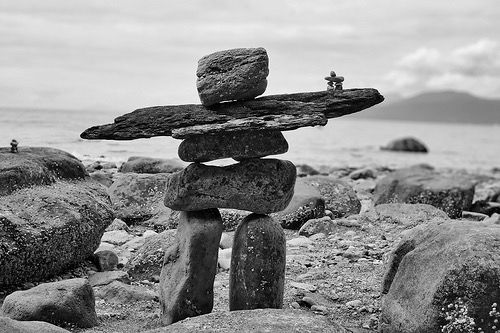 Inuksuit are stone markers built by the Inuit, Inupiat, Kalaallit, Yupik and other peoples of the Artic region of North America from Alaska to Greenland. This region, above the Artic Circle, is dominated by the tundra biome, containing areas with few natural landmarks.
Inuksuit are stone markers built by the Inuit, Inupiat, Kalaallit, Yupik and other peoples of the Artic region of North America from Alaska to Greenland. This region, above the Artic Circle, is dominated by the tundra biome, containing areas with few natural landmarks.
An inuksuk(the sungular of Inuksuit) can be anything from a single upright stone to the human shape cairn shown in the photograph. While you probably haven’t heard about them much now, you will soon as a human shaped inuksuk is the symbol of the 2010 winter olympics in Vancouver.
Their name means “thing that can act in the place of a human”. We are all familiar with things ‘that can act in the place of a human’, such as scarcrows, traffic lights, sign posts and memorials. An inuksuk can be used in many ways, but the main five are:
The stones to make an inuksuk are carefully chosen so that they could stand or lie upon one another without falling, no matter how fierce the storm. There are inuksuit that have been standing in the Artic for hundreds of years, probably even longer. Such old inuksiut are treated with great respect because they remind the Inuit of their ancestors. Even now, they can show the way to good hunting places, they can guide you when you are in a strange place and they can warn you of danger just ahead. In this way, an inuksuk is a gift from the past that keeps giving to anyone who comes its way.
When you look at an old inuksuk you are seeing more than just a stack of stones. You are seeing the thoughts of another person left upon the land, as you see the thoughts of another person in the words you read in a book, or a blog. Because the Inuit had no written language until quite recently, storytelling and such things as inuksuit were the ways that information was passed on from one generation to another. When travelling it is important to remember the shape of every inuksuk and the look of the land . By doing this the traveller makes a map in their head of the journey. It is possible for one person to tell another person how to get from one distant point to another by describing not only the landscape but also the shapes of the inuksuit along the way.
How does this relate to software? Software development is a strange, hybred, occupation; it is both art and science, people and machine, space unconstrained by the physical world. It is also relatively new. How do we know where to go and how to work in this new frontier? How do we chart our way across this landscape? We do it by exploring, experimenting and documenting our discoveries; in patterns and practices. These are our inuksuit, guiding those that come after.
When developing software we can say how we are going to operate by the practices and patterns we will follow. In doing this we are planning our journey, and can tell other people the route we intend to take by describing the inuksuit on our way. Different teams may well have the same inuksuit, or they may have different ones, it doesn’t matter as they will be on a different journey; we need the correct inuksuit for our own journey.
The other aspect I like in the comparison is that of time. Just like the Artic inuksuit, ours are of different ages. We tend to wrap ideas together as the next ‘big thing’, the latest bleeding edge approach. The reality is that it is all built on what went before, although I am tired of people telling me that there is nothing new in Agile development. In truth some of the things are old, like iterative development, and some are newer like continuous integration and automated testing. I like the idea that we are using the wisdom of those that passed this way before, and it makes me feel more part of a community.
Things like inuksuit are built all over the world, they just have different names in different languages. The desire to communicate information to other people over time is very human. Note : Most of the information about inuksuk was taken from Norman Hallendy’s introduction to the ‘The Inuksuk Book’ by Mary Wallace
 Mindsets
Mindsets